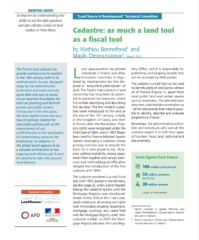
The French land cadastre has greatly evolved since its creation in the 19th century, both in its method and in its uses. Designed today by the administration to be more and more accurate, up to-date and easy to access, it is an essential foundation for land use planning and for both private and public owners. A fiscal tool in the first place, the land register serves also as a tool of common interest for new public policies such as the measurement of soil artificialisation or the localisation of compensatory measures for biodiversity. Its adoption in the global South appears to be a valuable contribution to the ongoing land reforms, yet it must be adapted to take into account local featurs.
This briefing note is also avalaible in French : here
This paper is not intended to promote a particular technique or tool, or encourage the application of similar technologies in Southern contexts. The aim is to provide some insight into their origins and the conditions for their implementation in very specific contexts, remembering that efforts to secure land tenure in Africa should support the local management and State regulation of existing practices. This may require different types of tools that need to be invented on a case-by-case basis.

Rejoignez-nous sur
LinkedIn